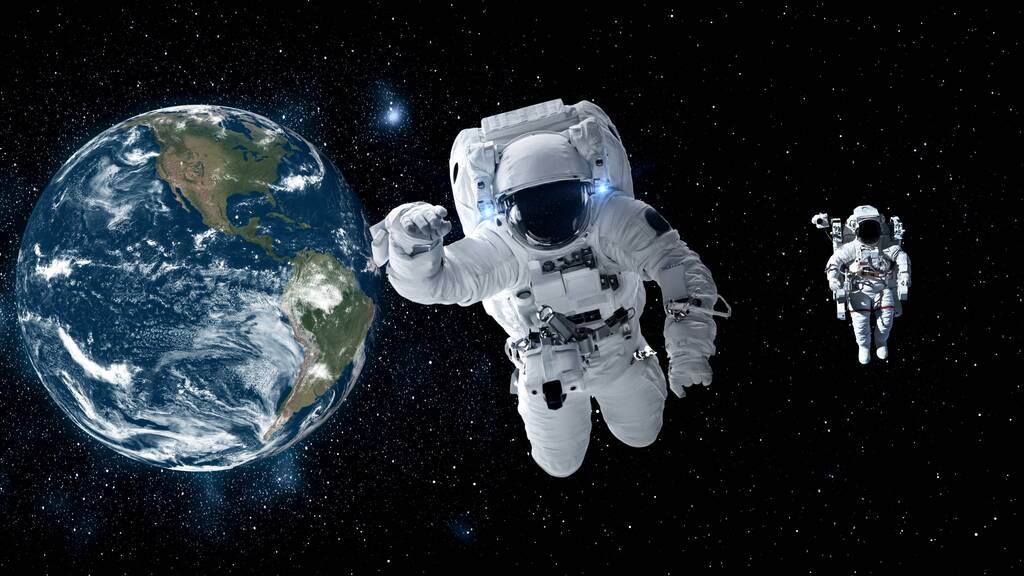Introduction
The idea of eternal youth or immortality has fascinated mankind for centuries. Ancient civilizations sought the elixir of life, while modern societies invest billions in anti-aging products and treatments.
The latest arena in this relentless pursuit of youth might surprise you – it’s not a secret fountain or a miracle cream, but the vast, infinite cosmos.
Yes, you heard it right. The newest frontier in anti-aging research is outer space. The intriguing notion that astronauts could potentially ‘turn back the clock’ while in space forms the crux of our investigation in this article, as we delve into the science behind the aging process and how space could impact it.
Our bodies, much like the universe, are constantly changing, evolving and, inevitably, aging. As we age, our bodies undergo a series of biological processes, some of which lead to the common signs of aging such as wrinkles, grey hair, and reduced physical and mental capacity.
The Science of Aging section will provide an in-depth understanding of these biological processes and the effects of aging on the human body.
The subsequent section, Anti-Aging Potential in Space, will take you on a journey beyond our atmosphere to explore the emerging research around how space might hold a key to slowing down, or even reversing, the aging process.
As improbable and science-fiction-esque as it may sound, research is revealing that space travel might have some unexpected effects on the human body that could potentially be harnessed for anti-aging purposes.
Building on these concepts, we then look at Anti-Aging Technologies in Space, where we explore the cutting-edge technologies currently available to astronauts to combat aging in space.
We will also peek into the future, to discuss potential new technologies that could be developed in response to the peculiar environment of space and its apparent influence on aging.
Understanding the Impact of these findings is crucial, and we will analyze the real-world implications of this groundbreaking research and technology. The potential benefits and risks, as well as the ethical considerations, will also be considered in this section.
As with any scientific advancement, it is essential to balance progress with caution, and the field of anti-aging in space is no exception.
Through this exploration, we will journey from the farthest reaches of space to the innermost workings of our cells.
From the awe-inspiring vastness of the cosmos to the microscopic marvels of our DNA, we will examine the potential of space travel to fight old age and, in the process, perhaps gain a new perspective on life here on Earth.
So, buckle up and prepare for a voyage through time and space as we seek to answer the question: Can astronauts turn back the clock? The Anti-Aging Potential of Space awaits.
The Science of Aging

Before delving into the fascinating concept of anti-aging potential in space, it is crucial to understand the basic science of aging. Aging is a natural biological process that affects every living organism.
In humans, it is a complex process characterized by a gradual decline in physiological function and metabolic processes, leading to increased vulnerability to disease and ultimately, death.
It’s an inevitable part of life’s cycle, yet scientists have endlessly strived to understand and potentially slow down the process.
At the cellular level, the aging process involves a number of biological changes. On the one hand, cells undergo a process known as senescence, where they lose their capacity to divide and function effectively.
This leads to a buildup of damaged and non-functioning cells which can contribute to aging and age-related diseases. On the other hand, there’s the shortening of telomeres – the protective end caps of our DNA strands, which occurs each time a cell replicates.
Over time, telomeres become too short to protect DNA effectively, leading to cell death or malfunction, a process intimately linked with aging.
Aging also involves changes at the biochemical level. Oxidative stress, thought to be a key player in the aging process, results from an imbalance between the production of harmful free radicals and the body’s ability to counteract their harmful effects.
This leads to damage to cells, proteins, and DNA, accelerating aging and the onset of age-related diseases.
Additionally, inflammation, often a response to injury or disease, tends to increase with age and can cause damage to healthy cells, tissues, and organs, further promoting the aging process.
Understanding the effects of aging on the human body provides the foundation for examining the anti-aging potential of space. Notably, the aging process affects nearly every system in the body.
The cardiovascular system, for example, experiences increased stiffness of the heart and blood vessels, leading to heightened risk of conditions like hypertension and heart disease.
Aging can also lead to decreased lung function, reduced kidney function, and changes in the digestive system.
The brain isn’t spared either, with cognitive decline, memory loss, and increased risk of neurodegenerative diseases like Alzheimer’s being key concerns.
This intricate interplay of cellular, biochemical, and physiological changes highlights the complex nature of the aging process.
How these processes might be affected or potentially reversed in space is a compelling question that scientists are keen to explore.
As we journey further into this discussion, it’s important to remember that the goal is not to eliminate aging – an unfeasible and arguably undesirable aim – but to better understand it, potentially slow it down, and improve health and longevity.
After all, the true measure of a successful fight against aging lies not just in the number of years added to life, but in the quality of those years.
Anti-Aging Potential in Space

The concept of expanding human lifespan by slowing down or reversing the process of aging has been a subject of scientific research for decades. And now, it seems, the final frontier – space – may hold the key to unlocking this age-old puzzle.
In 2015, Scott Kelly, an astronaut with NASA, spent almost one year at the International Space Station, while his identical twin brother, Mark Kelly, remained on Earth. This unique situation offered a rare opportunity for scientists to examine the effects of living in space on the human body.
One of the surprising findings was that Scott’s telomeres – the caps on the ends of chromosomes that shorten as we age – actually lengthened during his time in space. However, they quickly returned to their pre-flight lengths shortly after his return to Earth.
This suggests that while the space environment might temporarily reverse certain biological aspects of aging, the effects are not permanent.
Further research into the potential of space to reverse aging focuses on the role of microgravity. When astronauts are in space, they are in a state of constant free fall, resulting in an environment of apparent weightlessness or microgravity.
This microgravity condition has been shown in preliminary studies to impact various biological processes, including cell growth, gene expression, and organ function, all of which are intricately involved in the aging process.
For instance, researchers have found that microgravity can slow the degeneration of intervertebral discs, a common cause of back pain as humans age.
In addition, space’s hostile environment, including cosmic radiation and isolation, might also spur the human body’s defense mechanisms, leading to increased repair and renewal of cells.
This could potentially slow the aging process. However, this is still a hypothesis, and more studies are required to validate it.
While these findings are intriguing, it’s important to note that prolonged space travel also comes with its own set of health risks, including bone loss, muscle atrophy, and vision changes. So it’s far from being a fountain of youth.
However, understanding how the body adapts to life in space can provide valuable insights into the biological process of aging and inform the development of new anti-aging strategies.
In essence, space might not be the magic bullet to stop or reverse aging, but it offers an excellent platform for studying the aging process in a unique environment.
These studies will help to shed light on the mechanisms of aging and could potentially lead to new treatments for age-related diseases, extending human healthspan, if not lifespan.
Anti-Aging Technologies in Space

As we embark on the exploration of the anti-aging potential in space, it is crucial to delve into the current technologies available to astronauts to combat the effects of aging. Space, indeed, offers a unique environment for scientific and technological advancements, and anti-aging is no exception.
One of the current methods used to maintain astronauts’ health and slow down aging in space involves regular exercise.
An astronaut in space is required to exercise for about two hours daily to counteract the effects of the weightless environment on the body. This helps to slow down the muscle and bone mass loss that occurs in space, common signs of aging on Earth.
Another technological advance in this area is the use of specially designed space suits that can potentially slow down aging.
These suits, equipped with electromagnetic fields, are designed to replicate the Earth’s magnetic field, believed to have beneficial effects on the human body’s biological functions.
The suits aid in maintaining the astronaut’s circadian rhythm, which is crucial in regulating various body functions, including sleep patterns, hormone production, and cell regeneration, all of which influence the aging process.
Beyond the existing technologies, the potential for new anti-aging technologies in space is immense. The weightless environment in space could provide an unprecedented opportunity to develop medications and therapies that could slow down, halt, or even reverse the aging process.
Genetic engineering and nanotechnology are two fields that scientists believe hold great promise for anti-aging research in space.
Genetic engineering could allow us to alter the genes that control aging, while nanotechnology could give us the ability to repair or replace damaged tissues and cells at the microscopic level.
The potential uses of such anti-aging technologies in space are equally far-reaching. Astronauts could use these technologies to maintain their health during long-duration spaceflights.
For example, the development of a therapy that can slow down the aging of the cardiovascular system could enable astronauts to undertake missions that span several years without suffering severe health consequences.
Furthermore, these technologies could contribute to extending human lifespan far beyond the current average, even for those who never leave Earth.
However, while these technologies offer great promise, it is important to remember that they also present significant challenges. The development of effective anti-aging therapies will require years, if not decades, of research.
Furthermore, the long-term effects of these therapies are still unknown, and there is always the risk of unforeseen side-effects.
Moreover, the use of such therapies raises a number of ethical issues, such as who should have access to them and whether it is right to interfere with the natural aging process.
In conclusion, while space does offer significant potential for the development of anti-aging technologies, realization of this potential will depend on overcoming many scientific, technological, and ethical hurdles.
Nevertheless, the exploration of space continues to open new avenues for human advancement, and the quest for the fountain of youth may well be one of them.
Understanding the Impact

As we delve deeper into the potential of anti-aging in space, it becomes vital to consider the real-world implications that such technology might present.
The advent of anti-aging technologies in space could not only revolutionize the way we perceive the aging process, but it also has the power to redefine our understanding of human health and longevity.
Exploring the effects of space on the human body could lead to significant advancements in the sphere of biomedical research, potentially offering new perspectives on the treatment and prevention of age-related diseases.
However, alongside these potential benefits, we must also consider the potential risks associated with anti-aging in space. Long-term exposure to microgravity and space radiation could pose significant health hazards to astronauts.
For instance, radiation exposure has been linked to an increased risk of cancer, while microgravity can cause muscle atrophy and bone density loss. These factors could offset, or even exceed, any potential anti-aging benefits obtained from space travel.
Rigorous research and testing are, therefore, crucial to understanding these risks and ensuring that space travel remains safe for astronauts in the long run.
In addition, the potential for space travel to slow or reverse aging may open up a Pandora’s box of ethical considerations.
If space does indeed hold the key to ‘turning back the clock’, who should have access to this technology? Could this result in a societal divide between those who can afford to go to space and those who cannot?
Moreover, the concept of potentially living indefinitely can raise profound philosophical and moral questions about the nature of human life and death.
Potential misuse of such technology is another concern. If anti-aging technology can be exploited for personal gain or misused, it could lead to devastating consequences.
Strict regulations and ethical guidelines would be necessary to ensure that the technology is used appropriately and to prevent exploitation.
Lastly, while the potential of anti-aging technology in space is exciting, it is crucial to remember that the primary objective of space exploration is scientific discovery and understanding our universe better.
While its potential benefits to human health and longevity are certainly worth exploring, these should not overshadow the fundamental goal of expanding our knowledge about the cosmos and our place within it.
In conclusion, while the potential of anti-aging technology in space is vast, it brings along a set of potential risks and ethical concerns that need to be carefully considered and addressed.
A balanced, responsible approach is necessary, ensuring that the pursuit of anti-aging in space doesn’t compromise the health of astronauts, societal ethics, or the very essence of space exploration itself.
Conclusion
In the fascinating realm of space exploration, the potential of anti-aging technology brings with it a new frontier of possibilities.
Throughout this article, we have examined the scientific basis of aging, the potential of space to slow down or even reverse this process, and the technological advancements that may facilitate this intriguing concept.
It is clear that space presents a unique environment that, in conjunction with various technologies, may well provide the setting for a breakthrough in combating the effects of aging.
The potential implications of this technology cannot be overstated. If astronauts can indeed ‘turn back the clock’ during their time in space, the ripple effect could dramatically impact how we approach the aging process on earth.
This could lead to a drastic shift in our understanding of lifespan, health, and vitality. The healthcare sector could benefit enormously from these findings, potentially leading to new treatments for age-related diseases and extending the quality of life for individuals around the globe.
While the benefits are appealing, they must be balanced with an understanding of the potential risks associated with anti-aging in space.
The potential side effects of this process are unknown, and the safety of the technology is paramount. Moreover, space travel itself involves its own set of hazards, which must be addressed and mitigated.
However, as space agencies and private companies continue to invest in research and development, there is hope that these risks can be effectively managed.
Furthermore, the introduction of anti-aging technology in space also opens a Pandora’s box of ethical considerations. Questions around access to this technology, the potential for misuse, and the broader implications for society at large will need to be navigated carefully.
It is essential to foster an open dialogue to address these issues and ensure that anti-aging technology is used responsibly and equitably.
In conclusion, the promise of space travel to fight old age offers an exciting new chapter in human evolution. While there are undoubtedly challenges and uncertainties to be surmounted, the potential rewards are undeniably compelling.
As we continue to explore the stars, the possibility of a cosmic fountain of youth makes the journey all the more thrilling.
It is essential to remember that these developments are not merely about extending life, but also about enhancing the quality of life.
As we continue to push the boundaries of what is possible, we may just find that the answers to some of our most pressing questions about aging are not found here on earth, but in the vast, unexplored expanses of space.


One thought on “Can Astronauts Turn Back The Clock? The Anti-Aging Potential Of Space”